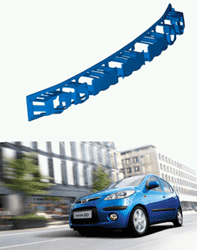2009-03-19
SABIC Innovative Plastics Continues Collaboration with Hyundai with New i10 Energy Absorbers for Improved Pedestrian Safety

BERGEN OP ZOOM, The Netherlands – March 19, 2009 – A-segment cars, also known as city cars, are growing in popularity due to their fuel-sipping benefits. But the very small size of these vehicles poses challenges to designers, so when designers of the Hyundai i10 – a city car produced by Hyundai Motor India Limited (HMIL) and targeted for export – were tasked with creating an energy absorber (EA) that would meet stringent European safety regulations for pedestrian lower leg impact, they faced space constraints for the EA, which required an alternative to bulky expanded polypropylene (EPP) foam. Based on Hyundai’s collaboration with SABIC Innovative Plastics on the QarmaQ Advanced Technology Demonstration Vehicle and the development of its Elastic Front safety system concept, HMIL selected Xenoy* polycarbonate/polybutylene terephthalate (PC/PBT) alloy. Because of the superior energy absorption efficiency of Xenoy resin compared to EPP, the HMIL team was able to comply with the EU requirements within the allotted space.
“Small city cars like the Hyundai i10 call for innovative materials that give designers greater flexibility and strength when space is at a premium,” said Umamaheswaran Venkatakrishnan, India Automotive director for SABIC Innovative Plastics. “Our technology team in Bangalore worked closely with HMIL and Hanilehwa, the EA supplier, to provide the best material for compliance with safety requirements, and to optimize the part design for top performance. Our side-by-side, long-term collaboration with automotive customers helps them deliver business success.”
With the revised EA design featuring Xenoy resin, the Hyundai i10 qualified for export to the EU. Further, it won the 2008 Indian Car of the Year award and a host of other honors. Within three months following i10’s European debut at the Bologna Motor Show in December 2007, HMIL achieved total sales of 196,632 vehicles. This comprised of 99,595 units from domestic sales and an additional 97,037 units coming from export.
Higher Energy Absorption Efficiency to Meet EEVC, WG17 Phase II Requirements
Xenoy resin provided several performance advantages over EPP that allowed Hyundai to comply with Phase II of the EU’s pedestrian safety standard. First, the resin provides 60-70 percent energy absorption efficiency compared to about 45 percent for EPP; this means Xenoy resin requires less space to deliver the required performance. It easily provided sufficient energy absorption within the very tight 45 mm space allotted by the EA design.
Second, the SABIC Innovative Plastics material delivers better performance than EPP at temperature extremes from -30°C to 60°C. Xenoy resin’s performance deviation is less than 10 percent, compared to close to 40 percent for the foam.
Information about the company: Sabic Innovative Plastics Denmark ApS